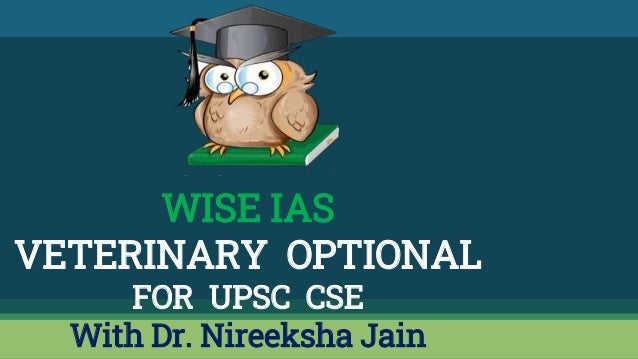
Lecture 17: Animal Diseases
- 1. WISE IAS VETERINARY OPTIONAL FOR UPSC CSE With Dr. Nireeksha Jain
- 2. Get The Wise IAS App Download lessons and learn anytime, anywhere with the Wise IAS app 2 Dr. Nireeksha Jain
- 3. ETIOLOGY, EPIDEMIOLOGY, SYMPTOMS, DIAGNOSIS, TREATMENT OF PRODUCTION DISEASES OF CATTLE, HORSE, PIG, POULTRY 17 3 LECTURE TOPICS
- 4. SUB- TOPICS 1) HYPOMAGNESAEMIC TETANY/ LACTATION TETANY 2) DOWNER COW SYNDROME 4 17 LECTURE
- 5. HYPOMAGNESAEMIC TETANY / GRASS STAGGERS/ Mg-deficiency It is a metabolic disease of Cattle, horse, buffalo characterised by hyperaesthesia, incoordination, tetany, convulsions as a result of disturbed magnesium homeostasis. ETIOLOGY A deficiency of magnesium in the blood stream is the principal cause of hypomagnesaemic tetany. The normal magnesium level is 2.3 mg/dl of blood. There is no fruitful mechanism for maintaining magnesium homeostasis.
- 6. 6
- 7. 7 CLINICAL SIGNS A) Acute Tetany • Sudden caesation to graze. • Twitching of the muscles and ears. • Staggering gait. • Nystagmus. • Frothing at the mouth. • Death occurs within half to one hour. • Unusual alertness. • Severe hyperaesthesia. • Bellowing. • Opisthotonus. • Champing of the jaws. • Temperature 104-105°F. • Heart sound increased may be heard from distance.
- 8. B) SUB- ACUTE TETANY • Onset is gradual. • Wildness of the facial expression. • Slight inappetance. • Vigorous limb movements. • Head throwing. • Spasmodic urination and frequent defecation. • Muscle tremor and mild tetany of hind limbs. C) Chronic Tetany. May not show clinical signs though serum Mg level is low. Vague syndrome like dullness, un-thriftiness, indifferent appetite.
- 9. DIAGNOSIS Incoordination, hyperaesthesia and tetany may be confused with the following: ▪ Acute lead poisoning: Blindness, history of lead access. ▪ Rabies: Straining, ascending paralysis, anaesthesia and absence of tetany. ▪ Nervous form of ketosis: Ketonuria; absence of tetany. Nitrate Poisoning: Absence of hyperaesthesia and convulsions. Coffee coloured urine.
- 10. TREATMENT • Satisfactory treatment is to administer solution containing both "Ca' and 'Mg' salts. A combined Ca-Mg preparation I/v followed by S/c injection of a solution of Magnesium salt. • Mifex @ 1 bottle or ½ bottle I/v. • The magnesium can be administered as enema. • A preparation containing 100 gm magnesium oxide along with 50 gm of calcium carbonate.
- 11. 11 CONTROL -Feeding of magnesium supplement. -Magnesium should be supplemented on daily basis in magnesium deficient pastures. This may be achieved by- • Adding magnesium salt in water • Adding magnesium salt in the feeds or concentrates • Spraying magnesium rich fertilizer as top dressing on pasture.
- 12. CONTROL • Addition of 3% magnesium oxide in the grain. • Addition of magnesium oxide @ 60 gm per cow along with water and molasses. • Addition of 5 -10 kg/200 litre of magnesium sulphate to drinking water. • Provision of molasses lick containing other minerals along with magnesium. • Use of magnesium releasing intra- ruminal bolus. • Protein supplementation as a carrier for magnesium oxide @ 6% per head per day.
- 13. DOWNER COW SYNDROME This condition is also ascribed as "Post parturient recumbency". This is frequently met in exotic and cross bred dairy cows. Holstein breed is most susceptible. Affected animals remain bright and alert but are unable to stand. This has also been considered as a special form parturient paresis.
- 14. ETIOLOGY The etiology of this disease is not distinct. Following factors have been identified as possible causes of downer cow syndrome :- • Persistant hypocalcaemia. • Resistant hypophosphaetemia • Hypokalaemia • Hypomagnesemia • Muscular injury • Nerve injuries • Hepatosis
- 15. 15
- 16. CLINICAL SIGNS 1. Most striking and common clinical finding of downer cow is inability to rise. The cow remains in recumbent position. 2. Cow remains bright and alert. 3. Appetite, rumination, defecation and urination are usually normal. 4. Temperature is usually normal but may turn towards sub- normal range in the terminal stage of the disease. 5. The affected cow usually crawl around utilizing the forelimbs whereas hind limbs remain in flexed position. This type of stance is ascribed as "creeper cow". 6. Some non-alert downer remains anoretic, dull and in comatose.
- 17. DIAGNOSIS Muscular injury- It is difficult to assess as swellings of thigh muscles as it is not easy to palpate. Extreme forward stretched position of leg is indicative. Nerve injury- Nerve and muscles injury may occur simultaneously. After lifting the cow in her feet it may be possible to locate the nerve injury of the affected limb. Myocardosis- It may not be possible to diagnose myocardosis clinically. This may be clinically manifested as tachythmia and jugular pulsation.
- 18. TREATMENT / PTRVENTION A. Management- Attempt should be made to lift the cow on its fore legs. Slings may he used for this purpose. Arrangement of soft bed should be made. When it is not possible to lift the cow frequent turning should be made. Cow should be turned at least at 3 hours interval. B. Therapy- There is no specific treatment for this syndrome.Re-placement therapy with calcium boro-gluconate is a must. Calcium, phosphorus, magnesium, glucose containing preparations can be used parenterally. Calcium preparation should be given with caution through intravenous route. Drugs like Vitamin E, selenium, potassium, vitamin D, Corticosteroids are recommended.
- 19. PREVENTION The cow should be bred with a bull as per its size to avoid Dystocia problem. Cow should not be made over fatty through too much feeding during advanced pregnancy. Periodical turning should be made in recumbent cow. Parenteral vitamin D, should be given in milk fever prone cow during pregnant period. Low calcium and high phosphorus diet should be given to stimulate parathyroid gland and thus to avoid hypocalcaemia. Recumbent cow following parturition should be given with intravenous calcium preparation.
- 20. THANKS! 20